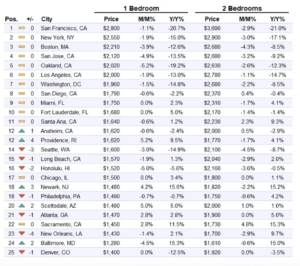According to Zumper’s November rent report, 13 out of 100 cities recorded record-breaking yearly decreases in one bedroom median last month, since Zumper started tracking median prices in 2015. The national one bedroom median rent decreased 0.5 percent last month to $1225. By comparison, in Denver, the average one bedroom rent decreased 12.5 percent to $1400 from a year ago.

Cities Reach Historic Yearly Decreases
13 cities (the most ever since Zumper started tracking the data) out of the 100 tracked in this rent report had record-breaking yearly decreases in 1-bedroom median last month since Zumper started tracking median prices in 2015. Those cities, in order of largest decrease, are: San Francisco, CA (-20.7%); Oakland, CA (-19.2%); New York City, NY (-15.0%); Seattle, WA (-14.9%); Washington DC (-14.8%); San Jose, CA (-13.5%); Los Angeles, CA (-13.0%); Boston, MA (-12.6%); Denver, CO (-12.5%); Irving, TX (-10.7%); Wichita, KS (-10.4%); Corpus Christi, TX (-8.9%); and Plano, TX (-8.4%).
Price Gap Decrease Between Expensive and Cheap Markets Continued
The gap in median prices between historically expensive rental markets and cheaper ones continued to decrease last month, but slowed slightly. The standard deviation of median one bedroom prices in the top 100 cities has decreased by 19 percent from a year ago. Large decreases in the top seven most expensive cities continued to account for most of the decrease in variance.
Colorado
In Denver, the average one bedroom rent decreased 12.5 percent to $1400 from a year ago. In Colorado Springs, a one bedroom median rent has decreased -5.1 to $940 from a year ago.
Nationally
Overall, the national 1-bedroom median rent decreased 0.5% last month to $1225, while the 2-bedroom median decreased 0.4% to $1483. In year-to-date terms, the 1-bedroom median was flat and the 2-bedroom median increased 0.3%.
The Zumper National Rent Report analyzes rental data from over 1 million active listings across the United States. Data is aggregated on a monthly basis to calculate median asking rents for the top 100 metro areas by population, providing a comprehensive view of the current state of the market. The report is based on all data available in the month prior to publication.









